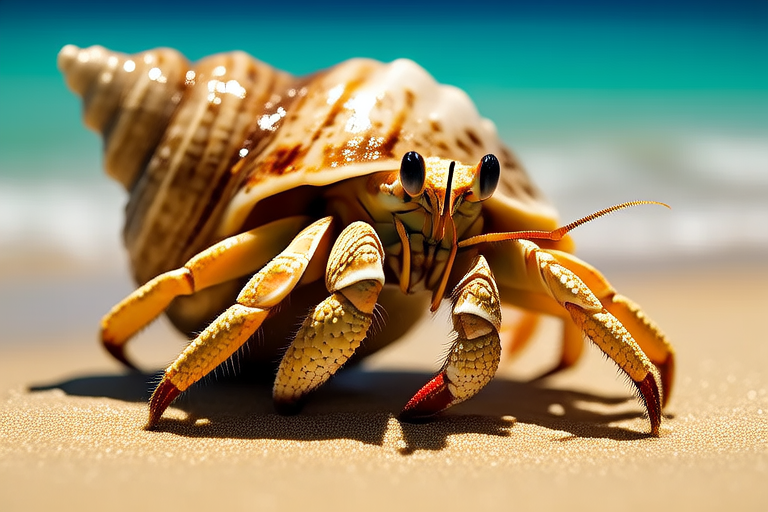The Intriguing Life of Hermit Crabs
Hermit crabs, with their endearing yet alien-like appearance, have captured the imaginations of many. These fascinating creatures offer a window into the wonders of marine biodiversity, and their unique behaviors and adaptations make them both adorable and otherworldly. This article delves into the captivating world of hermit crabs, exploring their habitats, behaviors, and the challenges they face in the wild. Additionally, it addresses the ethics of keeping them as pets and provides insights into proper hermit crab care.
Habitat Preferences and Adaptations
Hermit crabs are predominantly marine creatures, thriving in the rich environments of coral reefs, rocky shores, and sandy beaches. Their preference for these habitats is driven by the availability of food and shelter. Coral reefs, teeming with life, provide an abundance of food sources, from algae to small invertebrates. Rocky shores offer protection from predators and harsh weather conditions, while sandy beaches provide ample spaces for burrowing and foraging.
One of the most remarkable adaptations of hermit crabs is their reliance on discarded mollusk shells for protection. Unlike other crustaceans, hermit crabs do not develop a hard exoskeleton to shield their soft abdomens. Instead, they seek out empty shells, which they carry throughout their lives. As they grow, they must periodically trade up to larger shells, a process that can be fraught with competition and stress. This behavior underscores the importance of shell availability in hermit crab ecosystems.
Symbiotic Relationships and Ecological Roles
Hermit crabs play a crucial role in maintaining the health and balance of marine ecosystems through their symbiotic relationships. They often coexist with other species, such as sea anemones, which attach themselves to the exterior of the hermit crab’s shell. This partnership benefits both parties: the sea anemone gains mobility and access to a wider range of prey, while the hermit crab receives protection from predators due to the stinging tentacles of the anemone.
Additionally, hermit crabs contribute to nutrient cycling within their habitats. By scavenging and consuming organic matter, they help break down dead organisms and recycle nutrients back into the ecosystem. This process supports the growth of new life forms and ensures the sustainability of marine environments.
Unique Behaviors and Challenges
Hermit crabs exhibit a variety of unique behaviors that set them apart from other crustaceans. One of the most striking is their method of locomotion. Unlike other crabs, which walk sideways, hermit crabs can move in any direction. This flexibility allows them to navigate their complex environments more efficiently. Another notable behavior is their tendency to gather in large groups, particularly during mating season. These gatherings, known as “crab balls,” can involve hundreds or even thousands of individuals.
Despite their adaptability, hermit crabs face numerous challenges in the wild. Habitat destruction, pollution, and overfishing pose significant threats to their survival. The loss of coral reefs and coastal habitats reduces the availability of food and shelter, while pollution can contaminate their food sources and harm their respiratory systems. Overfishing of fish that predate on hermit crabs’ natural predators can also disrupt the delicate balance of their ecosystems.
Caring for Hermit Crabs as Pets
For those interested in hermit crabs as pets, understanding their specific needs is essential. Proper care involves creating an environment that mimics their natural habitat as closely as possible. A suitable tank should include a mix of sand, gravel, and rocks, along with plenty of hiding spots and climbing structures. Temperature and humidity levels must be carefully controlled to ensure the health and well-being of the hermit crabs.
Feeding hermit crabs is another important aspect of care. A balanced diet should consist of a variety of foods, including commercial hermit crab pellets, fresh fruits and vegetables, and occasional protein sources like fish or shrimp. It’s also crucial to provide a constant supply of clean, dechlorinated water and calcium supplements to support their shell health.
One common myth about hermit crabs is that they require saltwater. While some species do live in saltwater environments, many popular pet species, such as Coenobita clypeatus, are terrestrial and thrive in freshwater environments. Understanding these differences is key to providing appropriate care.
Ethical Considerations and Conservation Efforts
The ethical considerations surrounding the keeping of hermit crabs as pets are complex. On one hand, responsible pet ownership can raise awareness about these fascinating creatures and contribute to conservation efforts. On the other hand, irresponsible practices can harm wild populations and disrupt ecosystems.
To address these concerns, it’s important to purchase hermit crabs from reputable breeders who prioritize ethical sourcing and sustainable practices. Avoiding the collection of wild hermit crabs for the pet trade is crucial for preserving wild populations. Additionally, supporting conservation initiatives and participating in citizen science projects can help protect hermit crabs and their habitats.
Conclusion
The life of hermit crabs is a testament to the incredible diversity and adaptability of marine life. From their unique behaviors and symbiotic relationships to the challenges they face in the wild, hermit crabs offer a wealth of knowledge and wonder. Whether admired in their natural habitats or cared for as pets, these creatures remind us of the importance of biodiversity and the need for responsible stewardship of our planet’s resources.
